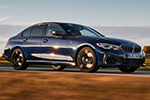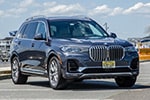When laser headlights debuted, BMW – and many other manufacturers – touted the impressive possibilities. Despite using 30 percent less energy, these lights returned twice the high beam range of (still somewhat advanced for the time) LED headlights. Laser lighting even had benefits as far-reaching as car design, as the physically smaller units allowed smaller housings and more creativity in designing front and rear fascias. Incredibly, the tech is already over ten years old – and appears that it may have come to a dead end.
The BMW i8 and Audi R8 LMX were the genesis of the laser lighting craze. BMW announced the i8’s lasers first, then Audi attempted a coup by bringing a 99-unit Audi R8 LMX out that also featured the revolutionary new lighting solutions. Unfortunately for Audi, BMW delivered their car to market first – June 5th, 2014, if you were curious – making the BMW i8 the first production car to feature laser headlights.
Of course, over time, laser headlights ended up finding their way onto plenty of BMW models in the last decade. High-end stuff like the 7 Series and iX, but also more accessible cars like the M3 and i4. But over the last couple years, astute shoppers and laser enthusiasts have already realized that the offering is vanishing from the BMW lineup.
The Laser is Dead; Long Live the Laser
Despite a well-fought battle against Audi, it seems it may have all been for naught. Despite the superior performance laser lighting can offer, the US Federal Motor Vehicle Safety Standard (FMVSS) still isn’t up-to-date enough to let laser headlights unleash their full power. In fact, adaptive driving beams in general weren’t even compliant until late in 2021.
The sticking point for adaptive headlights was a regulation from 1968 that didn’t account for adaptive beams using the high and low beams together. In contrast, traditional headlights have independently controlled low and high beams. The problem with laser lighting is simpler; they’re just too bright. Compliance systems in the US state a maximum of 150,000 candela, whereas Europe (which uses the UNECE vehicle regulations) allows up to 430,000. These restrictions leave laser lights in the dark, limited to performing only as well as, well, basically any other high-end lighting system made in the last ten years.
Since laser lights aren’t allowed to offer their enhanced range, it’s hard to find an argument that validates them. They’re certainly more expensive. And I don’t mean “expensive, but it’s a BMW,” I mean “carbon ceramic brakes” expensive. While I was still working at a BMW dealership, an M8 on the lot was damaged, and the cost (with shop time) to replace one laser headlight was $8,000.
The increased complexity and cost – with no tangible benefits – are why laser light offerings are disappearing from BMW offerings. The X7 and some 4 Series have them, but…that’s about it. The refreshed iX probably won’t have them, either. It’s a shame – the bright future that laser lighting once promised has all but dimmed in the US.








































































